-
Paper Information
- Next Paper
- Previous Paper
- Paper Submission
-
Journal Information
- About This Journal
- Editorial Board
- Current Issue
- Archive
- Author Guidelines
- Contact Us
Energy and Power
p-ISSN: 2163-159X e-ISSN: 2163-1603
2016; 6(1A): 28-32
doi:10.5923/c.ep.201601.05

Investigation on the Performance and Emissions Characteristics of CI Engine Using Different Blends of Waste Cooking Oil Methyl Ester-Ethanol-Diesel Oil
Vinoothan Kaliveer, Prajwal Raphael Sequeira, Rayan Veneeth D’sa, Simmons Antony Dsilva, Sandeep B., Rolvin S. D’silva
Department of Mechanical Engineering, St Joseph Engineering College, Mangalore, India
Correspondence to: Vinoothan Kaliveer, Department of Mechanical Engineering, St Joseph Engineering College, Mangalore, India.
| Email: |  |
Copyright © 2016 Scientific & Academic Publishing. All Rights Reserved.
This work is licensed under the Creative Commons Attribution International License (CC BY).
http://creativecommons.org/licenses/by/4.0/

In this study, performance and emission characteristics of waste cooking oil methyl ester, diesel oil and ethanol blends in a compression ignition engine are experimentally investigated. Work is carried out on pure diesel oil and blends B20, B20 with E10 and B15 with E5. Various physio-chemical properties of these fuel samples were determined. It has been observed that calorific value decreases for the blends when compared with diesel oil. The effect of waste cooking oil methyl ester blends on the engine performance and exhaust emissions has been examined at the injection pressure of 200 bar by varying the load. The experimental results observed that BTE for B20 with E10 blend is marginally higher compared to diesel oil and other blends at higher loads. BSFC increases by 1.03% for B20 with E10 at higher loads compared to diesel oil. NOx and CO emissions for B20 with E10 is lowered by 13.95% and 18.91% respectively compared to that of diesel oil at higher loads. HC emissions for B20 with E10 are 50% higher compared to that of diesel oil. Smoke opacity for B20 with E10 decreased by 35.85% compared to that of diesel oil at higher loads.
Keywords: Waste cooking oil Methyl Ester, Ethanol, Performance and emission characteristics
Cite this paper: Vinoothan Kaliveer, Prajwal Raphael Sequeira, Rayan Veneeth D’sa, Simmons Antony Dsilva, Sandeep B., Rolvin S. D’silva, Investigation on the Performance and Emissions Characteristics of CI Engine Using Different Blends of Waste Cooking Oil Methyl Ester-Ethanol-Diesel Oil, Energy and Power, Vol. 6 No. 1A, 2016, pp. 28-32. doi: 10.5923/c.ep.201601.05.
Article Outline
1. Introduction
- Diesel fuels have an important role in the industrial economy of any country. The high energy demand in the industrialized world and wide spread use of fossil fuels is leading to fast depletion of fossil fuel resources as well as environmental degradation. The degrading air quality due to emissions is the main adverse effect of petroleum based fuels. All the factors necessitate continued search and sustainable development of renewable energy sources which are environment friendly. Biodiesel is defined as fatty acid methyl or esters derived from vegetable oils or animal fats and it is used in diesel engine and heating systems. Thus, this fuel could be regarded as mineral diesel substitute with advantage of reducing greenhouse emissions because it is renewable resource. Biomass sources, particularly vegetable oils have attracted much attention as an alternate energy source. They are renewable, nontoxic and can be produced locally from agriculture and plant resources. Their utilization is not associated with adverse effects from the environment because they emit less harmful emissions and greenhouse gases. Vegetable oils have been promoted as possible alternatives for diesel [1]. The mineral diesel fuel is a complex mixture with carbon atoms ranging between 12 and 18, whereas vegetable oils are a mixture of organic compounds ranging from simple straight chain compounds to complex structures of proteins and fat soluble vitamins and are commonly referred to as triglycerides. Vegetable oils are usually triglycerides, generally with a number of branched chains of different lengths and different degrees of saturation. The vegetable oils having high viscosity are compared to mineral diesel. The vegetable oil is modified to reduce viscosity and to increase volatility. This methods employed include pre heating the oil, pyrolysis, micro emulsion, blending and transesterification. From the various studies it was found that the best way to make vegetable oil compatible with existing engines is to convert it into ester (biodiesel). In comparison to mineral diesel, biodiesel has a more favourable combustion and emission profile. Emissions of CO and particulate matter, hydrocarbon (HC) emissions decrease but NOx increase with biodiesel [2].
2. Fuel Sample used for CI Engine
2.1. Biodiesel from Waste Cooking Oil
- Biodiesel from waste cooking oil is a promising alternative to vegetable oil due to its reduced raw mineral cost. Waste oils from restaurants are less expensive than food grade oils. The use of waste cooking oil as a biodiesel source as the potential to reduce CO, particulate matter and other greenhouse gases, as the carbon contain in biomass derived fuel is largely bioorganic and renewable [3-5]. Since one of the major concerns on biodiesel production is the price of the feedstock, utilization of waste cooking oil significantly enhances the economic viability of biodiesel production. Huge quantities of waste cooking oil and animal fats are available throughout the world, especially in the developed countries. Management of such oils and fats pose significant challenge because of their disposal problems and possible contamination of the water and land resources. In India some of the hotels and restaurants are having the good practice of disposing off the used oil after reaching the degradation level. Some of these hotels and restaurants are ready to use biodiesel from the waste cooking oil which they produce for their stationary engines and generator sets. Many others are unaware of the potential of waste cooking oil they dispose. So technology has to be evolved and awareness has to be created. Biodiesel can be blended with diesel, and can be used in IC engines without any modifications [6].
3. Experimental Details
- The specification of the Diesel engine test rig used for the present work is given in the table 1.
|
3.1. Physio-chemical Properties of Diesel, Waste Cooking Oil, Waste Cooking Oil Methyl Ester and Blends
- The Physio-Chemical properties of Diesel, Waste cooking oil, Waste cooking oil Methyl Ester and blends were determined and tabulated in table 2. The diesel oil was taken directly for blending with Waste cooking oil methyl ester and Ethanol. These tests were carried out as per ASTM standards.
|
|
4. Results and Discussion
- The experiments were carried on direct injection, compression ignition engine for various loads, with injection pressure of 200 bar with different blends B20, B20 with E10, B15 with E5 and diesel. The load on the engine was varied from 0 kg to 12 kg. The compression ratio is kept constant at 17:1 for all the trials. The speed, fuel consumption, exhaust gas temperature readings were noted down for all the trials. The emission readings like, CO, CO2, HC and NOx was recorded by an AVL 5 gas exhaust gas analyser. Smoke is measured by a AVL smoke meter.
4.1. Performance Parameters
4.1.1. Brake Thermal Efficiency (BTE)
- Brake thermal efficiency is a measure of the performance of an engine considering the heat input and work output. BTE is slightly increased for blends compared to diesel fuel at high loads. This can be attributed to the rapid premixed combustion part possessed by ethanol blends because of improved mixing during ignition delay, oxygen enrichment, leading to higher percentage of ‘constant volume’ combustion and to the lower heat losses and ‘leaner combustion’ [7]. It is observed from the figure 1, that B20E10 gives better efficiency at 12 kg load than the other fuel samples. This may be because of the favourable properties of ethanol present in the blend which assists in the better combustion.
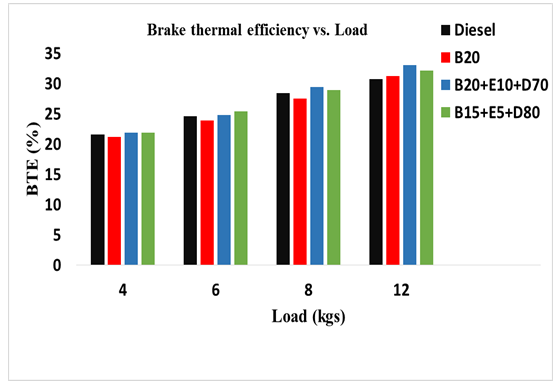 | Figure 1. Variation of brake thermal efficiency with load of various fuel blends |
4.1.2. Brake Specific Fuel Consumption (BSFC)
- Brake specific fuel consumption is a measure of fuel consumption to produce a known quantity of power. The BSFC are higher than that of diesel fuel at all the loads. BSFC increases with the proportion of ethanol in the blended fuel. The increase of BSFC is due to mainly lower calorific value of biodiesel and ethanol compared with diesel. BSFC for B20 with E10 increased by 1.03% compared to that of diesel oil at higher loads.
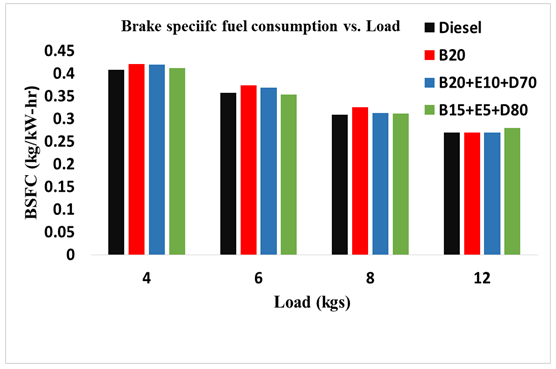 | Figure 2. Variation of brake specific fuel consumption with load of various fuel blends |
4.2. Emission Characteristics
4.2.1. Nitrogen Oxide Emission (NOx)
- Figure 3, Shows the variation of Nitrogen Oxide Emission versus load. It is observed from the figure that, as the load increases NOx emission also increases. This is expected because with increasing load, the temperature in combustion chamber increase and NOx formation is strongly temperature dependent phenomenon. At full load condition NOx emission is slightly greater in diesel compared to blended fuel. This lower NOx emission in blends could be due to lower temperature in the combustion chamber using B20 plus E10 blend. The reason of this decrease is considered to be the slower combustion of the fuel that results in a large period of combustion.
 | Figure 3. Variation of NOx with load of various fuel blends |
4.2.2. Carbon Monoxide Emission (CO)
- Figure 4 shows the variation of Carbon monoxide versus load. The results showed that the CO emissions are higher at lower loads and decreases slightly at higher loads for the blends compared to diesel fuel. The drastic increase in the CO percentage at low load for blend is due to decrease in the cylinder gas temperature and delayed combustion process. The lower temperature and delayed combustion would have suppressed the oxidation process even though enough oxygen was available for combustion. Slight reduction in CO emissions is noticed for blends at high load and that would be due to oxygen present in fuel and improved combustion process due to better mixing. CO emission for B20 with E10 show a decrease of 15% compared to that of diesel oil.
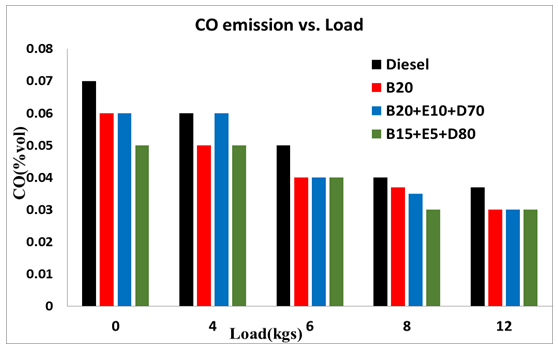 | Figure 4. Variation of Carbon monoxide with load of various fuel blends |
4.2.3. Unburnt Hydrocarbon (UBHC)
- Figure 5 shows the variation of Unburnt Hydrocarbon versus load. The higher oxygen content of biodiesel leads to better combustion resulting in lower emission of hydrocarbon, the major factor for large difference of HC emission is lower volatility of biodiesel compared with diesel. HC concentration increases with the addition of ethanol as the cetane number of ethanol is lower than those of biodiesel and diesel oil, ignition delay is increased in this case, thus causing incomplete combustion and consequently, increased HC emission. HC emission for B20 with E10 increased compared to that of diesel oil.
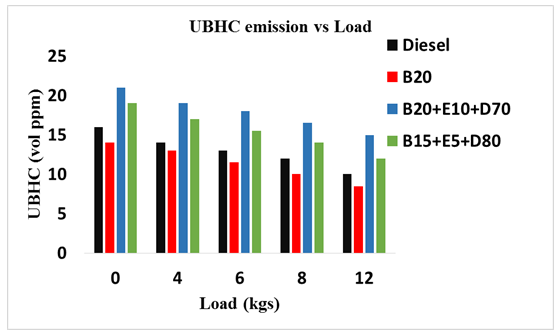 | Figure 5. Variation of unburnt hydrocarbons with load of various fuel blends |
4.2.4. Smoke Opacity
- The formation of smoke strongly depends on the engine load. As the engine load increase the smoke opacity also increase and the fuel injection is also more, increase in smoke in diesel compared with B20 with E10 at full load as shown in the above graph. As the blend ratio increase smoke opacity is decreased at full load. Smoke opacity for B20 with E10 decreased by 35.08% compared to that of diesel oil.
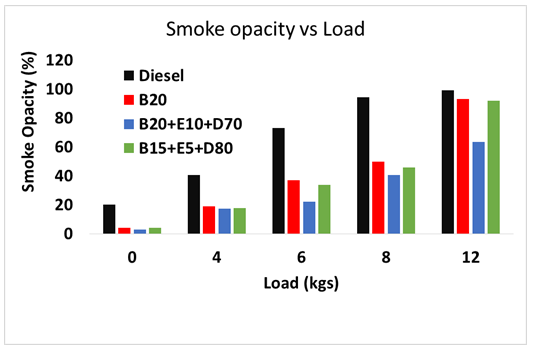 | Figure 6. Variation of smoke opacity with load of various fuel blends |
5. Conclusions
- The objective of this study is to investigate the engine performance and emission of diesel engine operating on ethanol biodiesel-diesel blends and compare these results with those operating on neat diesel oil and B20. BTE increases with the increase in engine load, it is also observed that BTE for B20 with E10 blend is higher compared to that of diesel oil and other blends. BTE is increased marginally for B20 with E10 when compared with diesel oil at full load. BSFC decreases with the increase in engine load. BSFC increased for ethanol blends at higher loads. NOx increases with increase in engine load, at higher loads the NOx emissions for ethanol blends is lower compared to that of diesel oil. CO emissions decreases with increase in engine load, at higher loads the CO emissions for ethanol blends are lower compared to that of diesel oil. Emission of HC is higher compared to that of diesel oil. Better results are obtained for B20 with E10 blend compared to all other blends and diesel oil.
 Abstract
Abstract Reference
Reference Full-Text PDF
Full-Text PDF Full-text HTML
Full-text HTML

